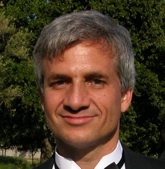
Philippe Goldin, Ph.D. is a research scientist and heads the Clinically Applied Affective Neuroscience group in the Department of Psychology at Stanford University.
He spent 6 years in India and Nepal studying various languages,
Buddhist philosophy and debate at Namgyal Monastery and the Dialectic Monastic Institute, and serving as an interpreter for various Tibetan Buddhist lamas. He then returned to the U.S. to complete a Ph.D. in Clinical Psychology at Rutgers University. His NIH-funded clinical research focuses on (a) functional neuroimaging investigations of cognitive-affective mechanisms in adults with anxiety disorders, (b) comparing the effects of mindfulness meditation and cognitive-behavioral therapy on brain-behavior correlates of emotional reactivity and regulation, and (c) training children in family and elementary school settings in mindfulness skills to reduce anxiety and enhance compassion, self-esteem and quality of family interactions.
Dr. Goldin will be one of the featured speakers at the upcoming conference on Happiness and Its Causes in San Francisco, Nov. 24 through 25, 2008.
Discover these discount codes for you!: Angie’s List and 10% off on printer ink at 4inkjets and 10% off on Shoes and other apparel at ShoeBuy.com.
A psychology podcast by David Van Nuys, Ph.D.
Podcast: Play in new window | Download
Subscribe: Apple Podcasts | RSS
Yoga (Application) which was based on the control of the body physically and implied that a perfect control over the body and the senses led to knowledge of the ultimate reality. A detailed anatomical knowledge of the human body was necessary to the advancement of yoga and therefore those practising yoga had to keep in touch with medical knowledge. (Romila Thapar, A History of India, volume one).
I suggest : Mind and brain are two distinct things. Brain is anatomical entity whereas mind is functional entity. Mind can be defined as the function of autonomic nervous system (ANS). It is claimed that mind can be brought under conscious control through the practice of meditation. But how? ANS is largely under hypothalamic control which is situated very close to optic chiasma (sixth chakra or ajna chakra). Protracted practice of concentration to meditate at this region brings functions of ANS say mind under one’s conscious control.
ANS is further divided into parasympathetic nervous system (PSNS) and sympathetic nervous system (SNS). On the basis of these facts I have discovered a mathematical relationship for spiritual quotient (S.Q.). Spiritual Quotient can be expressed mathematically as the ratio of Parasympathetic dominance to Sympathetic dominance. PSNS dominates during meditative calm and SNS dominates during stress. In this formula we assign numerical values to the physiological parameters activated or suppressed during autonomic mobilization and put in the formula to describe the state of mind of an individual and also infer his/her level of consciousness.
Protracted practice of meditation under qualified guidance will help to manage all sort of psychological problems.
Emotional Quotient can also be expressed mathematically as the product of I.Q. and Wisdom Factor.
Anirudh Kumar Satsangi
E.Q. stands for Emotional Quotient. An intelligent person may not be wise. But a wise man will always be intelligent. An intelligent person having certain level of positive emotions can be said as wise. An intelligent person lacking wisdom will turn autocrat. A wise man will always be a democrat who respects others existence.
If Mental Age of I.Q. can be quantified then Wisdom can also be quantified, of course, comparatively with more efforts.